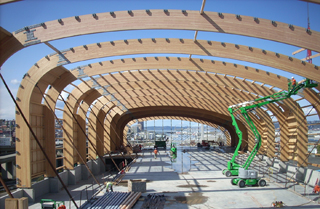|
Subscribe / Renew |
|
|
Contact Us |
|
| ► Subscribe to our Free Weekly Newsletter | |
| home | Welcome, sign in or click here to subscribe. | login |
Construction
| |
 |
May 31, 2012
4 must-haves for a successful civic project
JTM Construction

Hayduk
|
Throughout my career I have been involved with some of the region’s most iconic civic projects.
Among them are three performance venues — Benaroya Hall, McCaw Hall and McIntrye Hall (in Mount Vernon) — and three museums, including the Frye Art Museum, Museum of Glass, and the recently completed LeMay — America’s Car Museum.
All these projects share four common elements that made them successful for the client and project team.
Preconstruction
The most common element to successful projects is a preconstruction service where the owner, design team and contractor work as one.
On civic projects like LeMay it’s not unusual for no one to be sure how long the preconstruction schedule might last. These projects can’t begin until fundraising milestones have been reached.
Preconstruction service on LeMay lasted about 15 months after JTM joined the team, about halfway through construction drawings. Nevertheless the team came together and assisted the owner in some value engineering that saved the project budget more than $2 million.
Fundraising
When a contractor gets involved with civic projects for nonprofit organizations it’s fair to assume the company will be part of the fundraising team.
This scope of work can vary greatly. Whether it is hard-hat tours for prospective donors or formal fundraising parties inside the facility before the building achieves occupancy, one of the best marketing tools for that nonprofit organization is the construction of the building.
LeMay was no exception. JTM Construction provided more than a thousand tours of the building during construction, and a sneak-peek gala was attended by more than 600 active and prospective donors.
Subcontractors
Whether the project needs special acoustic requirements, back-of-house logistics, special event space or is a unique shape, most of these projects are one-of-a-kind buildings.
The project team must be able to get out of the box and not be afraid to try something that has not been done before. This means that the contractor must spend extra time and effort to find the subcontractors who want to invest in their community by taking a chance and trying something new.
The $2 million in savings during the value-engineering phase of preconstruction was mostly generated by four subcontracting trades.
One of the first changes was converting the wood roof structure to a design-build system. Western Wood Structures designed the roof structure to be panelized on the ground and then erected into place. Additional changes to the wood purlin and plywood systems enabled the team to achieve over $600,000 in total project savings.
In the concrete structure, SAK Concrete converted the precast concrete panels into tilt-up construction. Only after the panels were erected did SAK begin the three levels of structural concrete elevated floors. This approach saved the construction budget over $300,000 and made the outside of the building more visually appealing.
Lastly, by converting the mechanical and electrical to design-build and modifying the systems provided, PSF Mechanical and Holmes Electric were able to reduce the mechanical and electrical budget by $850,000.
Passion
The construction industry is intense and difficult and requires hard work. It is also a creative, progressive and evolving industry.
Civic projects such as museums and performance venues are rife with challenges and require more than just extra effort — they require a passion for the arts, a passion that will stimulate the team to solve issues creatively, and a passion that will carry the team across the finish line.
Whenever we complete a project at JTM we do a post-project review to make sure we met the goals we set before the project began: Did we exceed the owner’s expectations? Did JTM and the design team work as one? Did our subcontractors achieve their goals?
On these civic projects this review is easy. These projects provide such a sense of pride for the project team that the journey down the long construction road is always worth it. Projects for the arts have that one additional dimension: They stir passion for something bigger than individual success.
For the team of JTM Construction, the architects and engineers, the subcontractors and the field crews who worked so very hard, completing a project like LeMay is as good as it gets.
John Hayduk is president of JTM Construction, a wholly owned subsidiary of Fisher Companies, a privately held construction services company.
Other Stories:
- Cadillac project on a Model T budget
- HVAC system keeps LeMay breathing easy
- LeMay structure: function with flair



